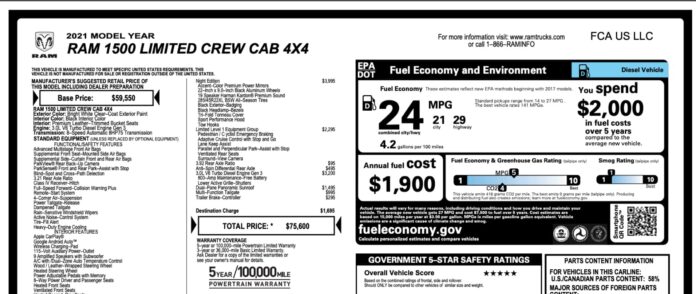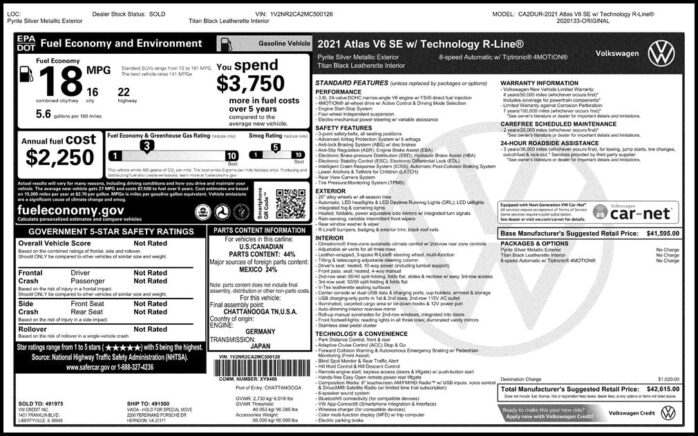
Have you ever purchased a new car and noticed the sticker on the window that says MSRP? What about those little stickers with numbers and letters, like “MSRP: $21,000?” These are called addendum stickers. The two different types of window stickers can be confusing for many used car buyers, so we’ll break them down for you.
If you are a car dealership looking for a great supplier for auto dealer supplies including custom and stock dealer addendum stickers and other dealer window stickers, consider visiting MBR Marketing at https://mbrmarketing.com/dealer-supplies/addendum-stickers.
MSRP Window Sticker

The Manufacturer’s Suggested Retail Price (MSRP) is the price that a manufacturer suggests retailers should sell their vehicles for. The MSRP sticker is usually found on new cars, and it lists the manufacturer’s suggested price for the car, standard equipment, and delivery charges. The MSRP might be a little different in your area, but it’s a good starting point for negotiations. The MSRP sticker will also list the car’s features and options, as well as the estimated fuel economy.
What you need to know about MSRP windows stickers is that most dealerships also use the sticker as a starting point for their negotiations. They’re not forced to sell their vehicles at the full MSRP price. That means that you can usually expect to pay less than what’s listed on the sticker, but it’s not guaranteed. Of course, they are many other factors to consider, but it’s still a good place to start.
You should also be aware of fake window stickers on new cars. You’ll commonly find these fake stickers exactly where the real MSRP stickers would be. Shady dealerships have fake MSRPs which they will show you when negotiating the price for their cars. They might even have a “buy now” price that’s much higher than the MSRP. Use your common sense and look out for red flags when entering the lot. If a sticker doesn’t look quite right, it probably isn’t.
Remember that the law requires dealerships to display an MSRP sticker on every new vehicle, and these must not be altered. The law has been put into place to ensure that consumers are not misled regarding the price of a vehicle. If you don’t see a sticker anywhere, ask the salesperson to show it to you. If they say there isn’t one or try and tell you a different price than what’s on the sticker, you should walk away.
Addendum Sticker

The addendum sticker is usually found in the lower right-hand corner of the window and lists the dealer’s invoice price, which is what they paid for the car. It will also include additional fees, such as transportation or preparation charges and additional accessories, features, and products that make the vehicle “more valuable.” This sticker should be separate from the MSRP sticker. The addendum price is important to know when negotiating because it’s closer to what you should be paying for the car. In fact, it combines the MSRP and everything else.
Remember that the dealer’s invoice price is not where to start negotiations. You want to negotiate from the MSRP in combination with your knowledge. You’ll simply have more leverage if you know what the dealer paid for the car. The addendum price is also important to know if you’re looking at a used car because it can help you determine if the dealer is overcharging.
The addendum sticker will also list any manufacturer’s incentives that were applied to the car. This can be a great bargaining chip when you’re shopping for used cars. For example, if the dealer just received two identical vehicles with $500 incentives, you could expect to pay less for the vehicle without the incentives.
There are also invisible items including nitrogen-filled tires, paint guards, market adjustments, non-optional and obligatory paint protection that are often times tacked onto the car’s final sale price. Dealers may also add addendums to vehicles that have done a legitimate modification. These may include suspension lift kits, tube steps, running boards, and aftermarket wheels.
It’s important to note that dealers will not typically disclose the addendum in any of their sales prices online. That’s why it’s a good idea to ask the dealer what numbers you’re looking at before making any decisions. This will also give you more leverage when negotiating the price of the car.
Using MSPR and Addendum Stickers to be a Savvy Used Car Buyer
When you’re looking at a car, it’s important to look at both stickers to try to get the best deal. Again, use the MSRP window sticker as a starting point for negotiations and be prepared to walk away from the table if the dealer doesn’t come down on the price.
Now that you know a little more about MSRP window stickers and addendum stickers, you’ll be more prepared when shopping for your next car. Remember, you have all the power when it comes to negotiating with a dealership. The more knowledge and leverage you have, the better your chance of scoring a great deal.
To be a savvy used car buyer, it’s important to understand everything that’s listed on both the MSRP window stickers and addendum stickers to increase your leverage. You must remember that the dealer’s invoice price is not where you should be starting your negotiations. You want to negotiate from the MSRP in combination with your knowledge.

Always do your due diligence to ensure that the car you’re looking at is a good deal. Be wary of fake stickers and “bait and switch” tactics that some dealers employ. If a vehicle has an addendum sticker on it, you should ask the dealership to show you the numbers behind it. If they refuse, it’s best to take your business elsewhere as the refusal is a big red flag.
Always take into account the dealer’s perspective when negotiating to find some common ground. If you’re in a strong position, ask to speak with the sales manager to negotiate even further. Dress appropriately, smile, be polite, speak with confidence, and remember that you have the power as the buyer.





